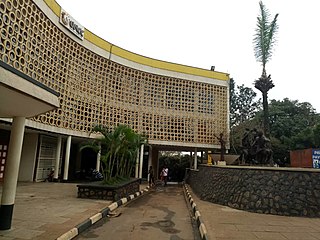This article contains a list of national cultural sites in Uganda in the Central Region of Uganda as defined by the Uganda Museum. [1] [2]
| ID | Site name | Description | District | Location | Original function | Coordinates | Image |
|---|---|---|---|---|---|---|---|
| UG-C-001 | Speke Memorial Monument | Spot where explorer John Speke stood and sighted the source of the river Nile in 1862 | Buikwe |  | |||
| UG-C-002 | Mabira Forest | Cultural resource, with indigenous, herbal medicinal trees | Mukono | 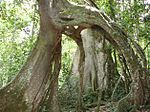 More images More images | |||
| UG-C-003 | ? | Bukomansimbi | |||||
| UG-C-004 | ? | Butambala | |||||
| UG-C-005 | Buvuma Island | Sangoan Later Stone Age site with earthworks and rock art paintings | Buvuma |  | |||
| UG-C-006 | ? | Gomba | |||||
| UG-C-007 | Ssese Islands | The islands are rich in Middle Stone Age artefacts (flakes, tortoise cores and rough picks), late Stone Age artefacts (waste, flakes chips and small cores), and Iron Age materials (from the earthworks) | Kalangala |  More images More images | |||
| UG-C-008 | Luggo Forest | Site where the Ddamula, or scepter for Buganda Kingdom's king, was obtained | |||||
| UG-C-009 | ? | Kalungu | |||||
| UG-C-010 | Independence Monument | Statue commemorating the 1962 Independence Monument, representing an adult lifting a newborn (Uganda) | Kampala | 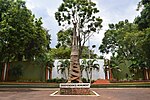 More images More images | |||
| UG-C-011 | Independence Tablet | Commonwealth independence – 9 October 1962 – Jubilee Park | Kampala |  | |||
| UG-C-012 | Kololo Monument | Monument commemorating 50 years of independence | Kampala | ||||
| UG-C-013 | Kololo Hero Monument | Ignatius Musaazi, independence liberation hero | Kampala |  More images More images | |||
| UG-C-014 | Kololo Ceremonial Grounds | Commemoration of Uganda's independence on 9 October 1962. It was last redeveloped on 9 May 2012. [3] | Kampala |  More images More images | |||
| UG-C-015 | Mackay Memorial, Nateete | Anglican Church at the site of the first Church Mission Society settlement (1890), headed by Reverend Alexander Murdoch Mackay | Kampala |  More images More images | |||
| UG-C-016 | Busega Martyrs Memorial | Rubaga, where three Anglican martyrs were killed and buried | Kampala |  More images More images | |||
| UG-C-017 | Bulange | Royal seat of the Buganda Kingdom | Kampala |  More images More images | |||
| UG-C-018 | Nagalabi Buddo | Coronation site for Buganda Kings | Kampala | ||||
| UG-C-019 | All Saints Church Kisozi | One of the oldest churches in Uganda | Kampala | ||||
| UG-C-020 | Shree Shanathan Dharma | 1954 Hindu temple, in its original form, with rich oriental architecture and a model for traditional building | Kampala |  More images More images | |||
| UG-C-021 | Lubaga Cathedral | Seat of the Catholic church in Uganda | Kampala |  More images More images | |||
| UG-C-022 | Nabulagala Mapeera church | Seat of the Anglican church in Uganda, a historic cave and historic buildings built by missionaries. The first cathedral was built in 1890–1894 of mud and wattle | Kampala |  More images More images | |||
| UG-C-023 | Gadaffi Mosque | The main seat of the Chief Khadi of Ugandan Muslims | Kampala |  More images More images | |||
| UG-C-024 | Kibuli Mosque | Seat of the Muslim faith built in 1945 by the Agha Khan and Prince of Buganda | Kampala |  More images More images | |||
| UG-C-025 | Baháʼí Temple | Seat for the Baháʼí Faith in Uganda | Kampala | 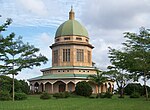 More images More images | |||
| UG-C-026 | Lusaze Lubya Church | Catholic mission of 1879 Kijukizo church | Kampala | 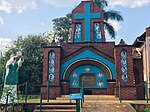 More images More images | |||
| UG-C-027 | Fort Lugard, Old Kampala | Established by Captain Frederick Lugard in 1890, served as headquarters until 1894 and survived as the first museum in the country and the Gaddafi mosque | Kampala |  More images More images | |||
| UG-C-028 | Aga Khan Mosque | Old Kampala | Kampala | Martin Road | 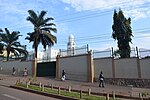 | ||
| UG-C-029 | St Athanasius Bazzekuketta | Mengo Memorial, Catholic martyr | Kampala | ||||
| UG-C-030 | St Matiya Mulumba | Site in memory of the first of the 22 Catholic martyrs | Kampala |  | |||
| UG-C-031 | High Court building Nakasero | Seat of the highest court in Uganda | Kampala |  | |||
| UG-C-032 | Parliamentary building | Meeting place of Ugandan lawmakers | Kampala |  More images More images | |||
| UG-C-033 | Uganda Bookshop | Oldest bookshop, established in 1927 as a publishing and printing house | Kampala | 4 Colville Street |  More images More images | ||
| UG-C-034 | Makerere University Building | Ivory Tower building, one of the oldest iconic education institutions | Kampala |  More images More images | |||
| UG-C-035 | Basiima Bakyagaya house | Kagwa's house of the late Sir Apollo, built in 1903. Located on Kabaka Njagala Road | Kampala |  More images More images | |||
| UG-C-036 | Buganda court building | Mengo | Kampala |  More images More images | |||
| UG-C-037 | Doset building | Kampala | Makerere University |  | |||
| UG-C-038 | Naguru communications mast | Uganda's national television and radio | Kampala |  More images More images | |||
| UG-C-039 | Uganda Museum | Oldest museum in East Africa | Kampala |  More images More images | |||
| UG-C-040 | National Theatre | National culture centre | Kampala | 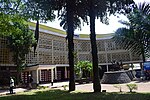 More images More images | |||
| UG-C-041 | Public Library | On Buganda House Road, in an Indian building | Kampala |  More images More images | |||
| UG-C-042 | Nommo Gallery | African village | Kampala |  | |||
| UG-C-043 | Tulifanya Gallery | Art gallery and craft shop | Kampala |  More images More images | |||
| UG-C-044 | St. Balikudembe (Owino) Market | Traditional market in centre of city | Kampala |  More images More images | |||
| UG-C-045 | Nakasero Market | Built in 1927 | Kampala |  More images More images | |||
| UG-C-046 | Mulago hospital | National Referral Hospital, Old Mulago, founded in 1913 by Sir Albert Ruskin Cook, while the New Mulago facility was completed in 1962 | Kampala | 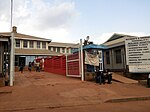 More images More images | |||
| UG-C-047 | Musa body metal works | Katwe plant for oil refining and brick making | Kampala |  | |||
| UG-C-048 | Twekobe Palace | Kabaka Mutesa II residential palace | Kampala |  More images More images | |||
| UG-C-049 | Butikkiro | Official residence of Katikkiro of Buganda | Kampala | ||||
| UG-C-050 | Kabaka lake | Manmade lake | Kampala |  More images More images | |||
| UG-C-051 | Kampala Club | Oldest club in Kampala | Kampala | Sezzibwa Road |  | ||
| UG-C-052 | Kisingiris House | historic building of the Kabaka's chiefs | Kampala |  | |||
| UG-C-053 | Tefio Kisonsokole | The first church built by Tefiro Kisosonkole on the spot where the Uganda martyrs were buried. Kisosonkole was a Buganda prime minister. | 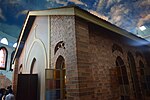 More images More images | ||||
| UG-C-054 | Sir Albert Cook's House | Makindye, Kabaka's birthplace | Kampala |  | |||
| UG-C-055 | Kawuta's House | Kampala | Ring Road | ||||
| UG-C-056 | CHOGM Monument | Impressive copper structure commemorating the hosting of the meeting of the heads of government in Uganda in 2007. | Kampala |  More images More images | |||
| UG-C-057 | Clock Tower | Commemorates the Queen's visit in 1954 | Kampala | Queen's Way |  More images More images | ||
| UG-C-058 | Kololo Airstrip | Monuments, burial for heroes, airstrip national functions | Kampala | ||||
| UG-C-059 | Constitutional Square | Upper part commemorates World war II victims. Lower part is the monument of the constitutional square | Kampala |  More images More images | |||
| UG-C-060 | Kasubi Tombs | Grass thatched round house containing the tombs and insignia of Mutesa I, and three northern subsequent rulers of Buganda | Kampala | 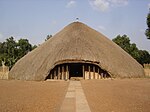 More images More images | |||
| UG-C-061 | Kasubi Masgid Tawahud Mosque | Built by Mutesa I in 1870 when he first had his capital at Kasubi, Nabulagala | Kampala | 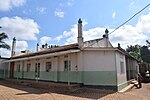 More images More images | |||
| UG-C-062 | Wamala Tombs | Grass thatched round hut very similar to Kasubi tombs, containing the tombs of Sunna II of the Buganda kingdom 1856 | Kampala |  More images More images | |||
| UG-C-063 | Mapeera Bakateyamba House Nalukolongo | Established by Mapeera to treat the disabled and the elderly | Kampala |  | |||
| UG-C-064 | Kiwewas Tombs | Tombs of King Kiwewa | Kampala | Masanafu |  More images More images | ||
| UG-C-065 | Old railway house | Railways building –More information | Kampala |  More images More images | |||
| UG-C-066 | GOU analytical lab | Built in 192, a historical building | Kampala |  | |||
| UG-C-067 | Corner House | historic buildings | Kampala | Plot 44 Rashid Hamis road |  More images More images | ||
| UG-C-068 | St Peter's Boys Nsambya | One of the first schools of the Hill Mill Fathers 1907 | Kampala | 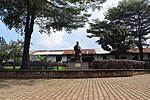 More images More images | |||
| UG-C-069 | Nsambya convent | Several historic buildings | Kampala | ||||
| UG-C-070 | Musajalumbwa house | Kampala | |||||
| UG-C-071 | Kisingiris House Mengo | Residential | Kampala | ||||
| UG-C-072 | Kakungulu's house | Kampala | |||||
| UG-C-073 | Gomboloa House | Balintuma road | Kampala | ||||
| UG-C-074 | Speke Hotel | Built in 1920, historical and has maintained colonial look | Kampala |  | |||
| UG-C-075 | Port Bell Pier | 1st- pier for large ships landing in Luzira | Kampala |  More images More images | |||
| UG-C-076 | Granda Imperial Hotel | One of the oldest hotels in Kampala, initially known as Grand Hotel | Kampala |  More images More images | |||
| UG-C-077 | Ruparellia Building | Martin Road | Kampala |  | |||
| UG-C-078 | Mawandas House | Salaama Road | Kampala | ||||
| UG-C-079 | Kampala Club | Ssezibwa Road | Kampala |  | |||
| UG-C-080 | Jimmy Purmas House | Salaama road | Kampala | ||||
| UG-C-081 | Centenary Park | Kampala | |||||
| UG-C-082 | Kalagala Falls | Falls with a series of natural and cultural caves | Kayunga | ||||
| UG-C-083 | Bukomero | Mass graves, NRA War memorial | Kiboga | ||||
| UG-C-084 | Lwamata | Mass graves and NRA war memorial | |||||
| UG-C-085 | Mpanga Forest | Several shrines and 16 springs are found here |  | ||||
| UG-C-086 | ? | Kyankwanzi | |||||
| UG-C-087 | Butuntumula Kikyusa, Zirobwe Makulubita | NRA War mass graves memorial | Luweero | ||||
| UG-C-088 | Walusii Hills | At Kikyusa is Muteesa' palace and main ancestral grounds | |||||
| UG-C-089 | Mulajje Cathedral Kasana | The 3rd catholic cathedral/seminary in the country was established in 1914by the white fathers after Daudi Chwa gave them 30 acres of land | |||||
| UG-C-090 | ? | Lwengo | |||||
| UG-C-091 | ? | Lyantonde | |||||
| UG-C-092 | Masaka Fort | Fort established and existed from 1897 to 1901, and originally the site of a church | Masaka | ||||
| UG-C-093 | ? | Missionary Society (CMS) station | |||||
| UG-C-094 | Villa Maria Building | First Catholic old mission church and brick house 1891 |  More images More images | ||||
| UG-C-095 | Kitovu Catholic Cathedral | Catholic church on the World Monuments Watch list |  More images More images | ||||
| UG-C-096 | Father Ngobya Memorial | Burial place for renowned Father Aloysius Ngobya at Kitovu Catholic church |  | ||||
| UG-C-097 | Kiwala Pit shafts | At Kako, are Kaolin pit shafts similar to those of Mityana for mining | |||||
| UG-C-098 | Tanda archaeological site | Old mining pit shafts (Kaolin) (Enyanga za Walumbe), totaling 400 in number | Mityana | ||||
| UG-C-099 | Kyamusisi | NRA War memorial, and mass burial grounds | |||||
| UG-C-100 | Magonga Shrines | 2 miles to Mudende Town are Kintus shrines | |||||
| UG-C-101 | Bukalamuli Catholic Mission | NRA war memorial, Kikandwa Lutta memorial, and diocese | |||||
| UG-C-102 | ? | ||||||
| UG-C-103 | Equator Monument | At Kayabwe circular arches on both sides of the road signify the equator crossing | Mpigi | 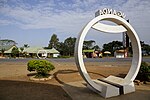 More images More images | |||
| UG-C-104 | Kibibi | NRA War mass grave | |||||
| UG-C-105 | Muduuma | NRA War mass grave | |||||
| UG-C-106 | Kiringa ente | NRA War mass grave at Luvumbula | |||||
| UG-C-107 | Kiringa ente Buto Buvuma | At Luvumbula again is a ritual site and place for the coronation of Saaza chiefs | |||||
| UG-C-108 | Mubende Hill (witch tree) | Last Chwezi Capital | Mubende | ||||
| UG-C-109 | Kanyogoga gorge | Corridor | |||||
| UG-C-110 | Lake Wamala | Receded from Lake Victoria, with active shrines of King Wamala |  | ||||
| UG-C-111 | Moniko Rock Engravings | Engravings and harrows on top of the hill | Mukono | ||||
| UG-C-112 | Kitale Rock Gong | Popularly known as Dindo's Rock with Kintus foot, print, etc |  | ||||
| UG-C-113 | Polish Refugee camp | Kojja (Mpunge) Polish Jewish refugees were exiled in Uganda in 1945 | |||||
| UG-C-114 | Kisweera | NRA War Memorial | |||||
| UG-C-115 | Kinanisi | Royal iron working and smelting site | |||||
| UG-C-116 | Ssezibwa Falls | Cultural site and forest resource with spiritual significance | 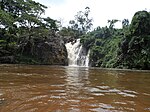 More images More images | ||||
| UG-C-117 | Ma Ngira forest | Traditional cultural forest resource | |||||
| UG-C-118 | Buvuma Islands | Rock paintings and cultural forests in Mpaata | |||||
| UG-C-119 | Ham Mukasa Home | Gulu, Nasuti Ham Mukasaa country residence | |||||
| UG-C-120 | Nambis cave shrine | In Kyagwe Hwere, the Kinti Nimbi and Walumbe are still worshiped, and soldiers, business, fraternity, and job seekers flock to the place for blessings | |||||
| UG-C-121 | Katikamu war memorial | Mass graves | Nakaseke | ||||
| UG-C-122 | Wakyato | Mass grave and memorial at the Sub county headquarters | |||||
| UG-C-123 | Kikamulo | Mass grave and memorial at Sub county headquarters | |||||
| UG-C-124 | Nakaseke | Mass grave and Memorial | |||||
| UG-C-125 | Semutto | Mass grave and Memorial | |||||
| UG-C-126 | Namunkekeera Kappeka | Mass grave and memorial | |||||
| UG-C-127 | Nakibinge Tombs | At Kitinda are shrines for Kabaka Nakibinge | |||||
| UG-C-128 | Bumera Tombs | Kanzinze Masuulita are shrines Kimeras | |||||
| UG-C-129 | Luwoko Katikamu Masulita | Kabaka Tembo's palace | |||||
| UG-C-130 | Oyite Ojok Memorial site | At Mijeera, plane crash site | Nakasongola | ||||
| UG-C-131 | Nakasongola Hill | Nakasongola named after a stone on Nakasongola hill that sticks out | |||||
| UG-C-132 | Kageri Hill, Wabinyoyi | Historically known by the Baruli for Protection against their enemies |  More images More images | ||||
| UG-C-133 | Macumu hill in Kikangula | King Kabarega resided here during his battles with the British (footprint prints are available) | 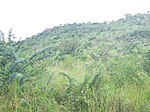 More images More images | ||||
| UG-C-134 | Kirooro | Nyinamwiru, the daughter of Bukuku, mother of Ndaula the Cwezi King, lived here | |||||
| UG-C-135 | Kyawaikaakata, Lwampanga sub-county | Kabalega and Mwanga were detained here before they were exiled to Seychelles | |||||
| UG-C-136 | Wakibombo | NRA Mass grave | |||||
| UG-C-137 | Muduuma tombs | Tomb of Winyi III Ruguluka Macolya | |||||
| UG-C-138 | Kamuswagas' palace | King of Kooki royal residence | Rakai | ||||
| UG-C-139 | Serinya Tombs | Kooki Kingdom royal burial grounds | |||||
| UG-C-140 | Simba Hills Monument Kasambya Fort ? | K.A.R.1914–18, Simba site, and a spot to view Lake Victoria | |||||
| UG-C-141 | Kasozi church | At Katuntu is the second oldest Catholic church | |||||
| UG-C-142 | Muzimu Caves | At Kasabya are ritual caves | |||||
| UG-C-143 | Rwanda Genocide Memorial | Graves at Kacencero/Kyebe/Rwandan genocide graves | |||||
| UG-C-144 | Katubi Tombs | Royal Burial grounds | |||||
| UG-C-145 | Kyarurangira | Hippos view | |||||
| UG-C-146 | Kiya hill | Archaeological sites of early Stone Age works | |||||
| UG-C-147 | Kigera cave | Along Kyotera-Mutukula road, it became popular during the pre-colonial wars between the Baziba of Karagwe | |||||
| UG-C-148 | Bigo bya Mugyenyi | Earth works, Archaeological Site Cwezi 13th- century to 16th century | Ssembabule | ||||
| UG-C-149 | Ntusi earthworks | Earth works, archaeological site Cwezi, capital 11th century | |||||
| UG-C-150 | Kasonko earthworks | Earthworks, Archaeological site | |||||
| UG-C-151 | Bwogero Basin | Several scrapped depressions and mounds, associated with rituals of the Cwezi | |||||
| UG-C-152 | Equator Crossing at Nshozi | Small Monument signifying equator crossing | |||||
| UG-C-153 | Lwentale Lyamugyenyi | Granite rock with rock sounds | |||||
| UG-C-154 | Hippo bay cave Entebbe | Archaeological, Oldowan and Acheulean tools site | Wakiso | ||||
| UG-C-155 | Omuti gwe Ddembe, Entebbe | Freedom site where Ignatious Musaazi held independence struggle meetings | Wakiso |  More images More images | |||
| UG-C-156 | Kigungu, Monument and Church | First catholic church Laudel & Amans Catholic missionaries landing, Mapeera monuments and church 1879 | Wakiso | 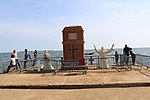 More images More images | |||
| UG-C-157 | Bugonga Church and Tree | Farther Laudel landed at Rigungu but camped at Bugonga | Wakiso |  More images More images | |||
| UG-C-158 | St Johns Church, Entebbe | Built by the first colonial Anglican masters in Entebbe, is one of the oldest buildings | Wakiso |  More images More images | |||
| UG-C-159 | Entebbe Cinema Hall | One of the first cinema halls used by colonial masters to watch films when Entebbe was headquarters | Wakiso | 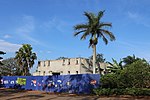 | |||
| UG-C-160 | Luzira Figurines | Iron Age stone tools including pottery(the Luzira Head at the Uganda Museum) | Wakiso | ||||
| UG-C-161 | Mpangas Shrine, Luzira | (Ekigwa) | Wakiso | ||||
| UG-C-162 | Buloba hill | Dimple based pottery | Wakiso | ||||
| UG-C-163 | Kazi, Busabala | Kazi Yacht Club meeting place of Stanley an Muteesa in 1875 | Wakiso | ||||
| UG-C-164 | Nalukolongo Martyrs | Museum | Wakiso |  More images More images | |||
| UG-C-165 | Namugongo Matyrs shrine | At Buloori is the catholic shrine | Wakiso |  More images More images | |||
| UG-C-166 | Namugongo Matyrs shrine | At Kyaliwajala is the Protestant shrine | Wakiso | 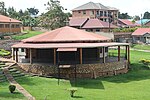 More images More images | |||
| UG-C-167 | Mamugongo Masgid Nuru | At Buloori, Moslem martyrs | Wakiso | ||||
| UG-C-168 | Kalemas Komera Katereke | Prison ditch for Buganda prince and Princesses | Wakiso | 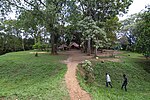 | |||
| UG-C-169 | Muganzi Lwaza Komera | Prison ditch located in Kisalosalo, Kyebando | Wakiso | ||||
| UG-C-170 | Muganzi Lwaza tombs mounds | Located in Kazo, Mpererwe – tombs and mounds | Wakiso | ||||
| UG-C-171 | Bagala yazze Tombs | At Mpererwe are tombs of Namasole Bagalayazze mother to Kabaka Mwanga II | Wakiso | ||||
| UG-C-172 | Kyabagu Tombs Kyebando | Tombs of the 25th king of Buganda ,Kyabagu ruled, 1750–1780 | Wakiso | ||||
| UG-C-173 | Kiwewea Tombs | At Masanafu Kiwewa | Wakiso | ||||
| UG-C-174 | Kimeras Shrine | Kabaka Kimeras jaw bone | Wakiso | ||||
| UG-C-175 | Kongoje Shrines | Jaw bone shrines of Kabaka Nakibinge, Sekamanya and Mutebi | Wakiso | ||||
| UG-C-176 | Equator crossing | In Lake Victoria Island | Wakiso | ||||
| UG-C-177 | Sir Apollo Kagwa | At Manyangwa is a mausoleum, residential house, and church | Wakiso |  | |||
| UG-C-178 | LEGICO Assembly building (currently housing NARO) | Seat of Uganda's first legislative council, parliament established by the British colonial government in 1920 by then all MPs were whites!! (NARO) | Wakiso |  More images More images | |||
| UG-C-179 | Old airport Entebbe | First (old airport, Israel's raid during Idi Amin's regime | Wakiso |  | |||
| UG-C-180 | Muzinga Square | Wakiso |  More images More images | ||||
| UG-C-181 | Entebbe za Mugula | Wakiso |  More images More images | ||||
| UG-C-182 | Lunyo Well | Well traditionally used by Kabaka of Buganda | Wakiso |  | |||
| UG-C-183 | Gombe | War memorial mass graves | Wakiso |  More images More images | |||
| UG-C-184 | Masulita | War memorial mass graves | Wakiso | ||||
| UG-C-185 | Kireka Wakiso | War memorial mass graves | Wakiso | ||||
| UG-C-186 | Kakiri | War memorial mass graves | Wakiso | ||||
| UG-C-187 | Namayumba | War memorial mass graves | Wakiso | ||||
| UG-C-188 | Busukuma | War memorial mass graves | Wakiso | ||||
| UG-C-189 | Kasanje | War memorial mass graves | Wakiso | ||||
| UG-C-190 | Kireka Palace | Current King Mutebi's official residence | Wakiso | ||||
| UG-C-191 | Banda Palace hill | Meeting place of Speke and Mutesa of 1862/also for Kabaka Mutebi | Wakiso | ||||
| UG-C-192 | Gayaza | Sangoan culture similar to Sango Bay | Wakiso | ||||
| UG-C-193 | Bulamu Palace | In Kasangati. Shrine/sacred place for Ndaula, Kiwanuka, and Wanemas spirits | Wakiso | ||||
| UG-C-194 | Ndaulas Shrine | At Kakooge, Buwaali | Wakiso | ||||
| UG-C-195 | Kakungurus House | Historic building at Kirinya | Wakiso | ||||
| UG-C-196 | Ziika Forest | Bemba's cave and indigenous herbal tress | Wakiso | ||||
| UG-C-197 | Mpanga Forest | Bird species and herbal trees and shrubs | Wakiso | ||||
| UG-C-198 | Entebbe Botanical Gardens | Exhibition of a variety of plants and herbs | Wakiso | 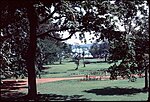 More images More images | |||
| UG-C-199 | Lutembe bay | Forests and bird species | Wakiso | ||||
| UG-C-200 | Lunyo Police station | First police station in Uganda | Wakiso |






